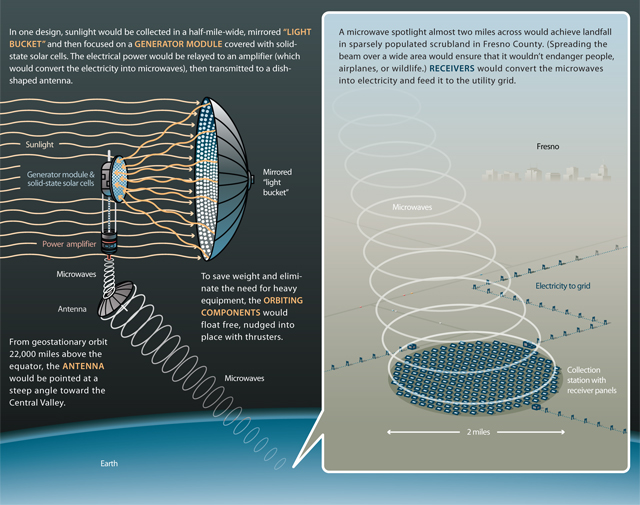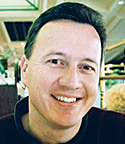sierraclub.org - sierra magazine - september/october 2010 - innovate
The sun never sets or hides behind clouds, and solar energy isn't filtered by the atmosphere's protective Ray-Bans. The National Security Space Office estimates that a one-kilometer-wide belt of space around Earth receives in one year an amount of solar energy equal to the world's oil reserves. A space-based solar station could stream power day and night, in any weather, to any latitude, in an amount that would dwarf the output of terrestrial solar and wind farms. Floating generators could send power directly to disaster areas, saving thousands of lives. Or they could be co-opted by a modern Ernst Blofeld and fashioned into death rays.
Click to see larger image.

Infographic: Brian Kaas Infographic
 Early in his career, Gary Spirnak decided he'd rather build a spaceship than ride in one. "I worked around a lot of astronauts, and it didn't seem that glamorous," he says of the days in the 1980s and '90s when he coordinated space shuttle flights for the U.S. Air Force.
Early in his career, Gary Spirnak decided he'd rather build a spaceship than ride in one. "I worked around a lot of astronauts, and it didn't seem that glamorous," he says of the days in the 1980s and '90s when he coordinated space shuttle flights for the U.S. Air Force.
In 2000, after stints operating ground stations and designing satellites for Hughes Space and Communications Company and Boeing, Spirnak, a spacecraft project engineer, pursued an idea that had first captivated him in college, during the energy crisis of 1973: launching solar panels into space, a concept introduced by science fiction author Isaac Asimov in 1941.
Spirnak and several aerospace industry colleagues founded Solaren, which last year got approval from Pacific Gas & Electric Company and California regulators to beam 200 megawatts of electricity from Earth orbit to an oval-shaped collection station in a remote corner of the state's rural Central Valley.
The project, scheduled to start producing power in 2016, is expensive and literally "out there," but Spirnak views his cow-pasture cosmos as just a test flight. He talks about 1,500-megawatt arrays that could direct power to cities, disaster areas, and deployed military units.
"Once it's proven here, we could have all of east Asia, or Europe and Africa," he fires off machine-gun fast.
Spirnak believes our space forays should have their most profound implications here on terra firma. "The more we realize we're a little blue ball in the middle of nowhere, and the more people see Earth as the fragile planet it is," he says, "the better off we're going to be."
—David Ferris
This article has been corrected.